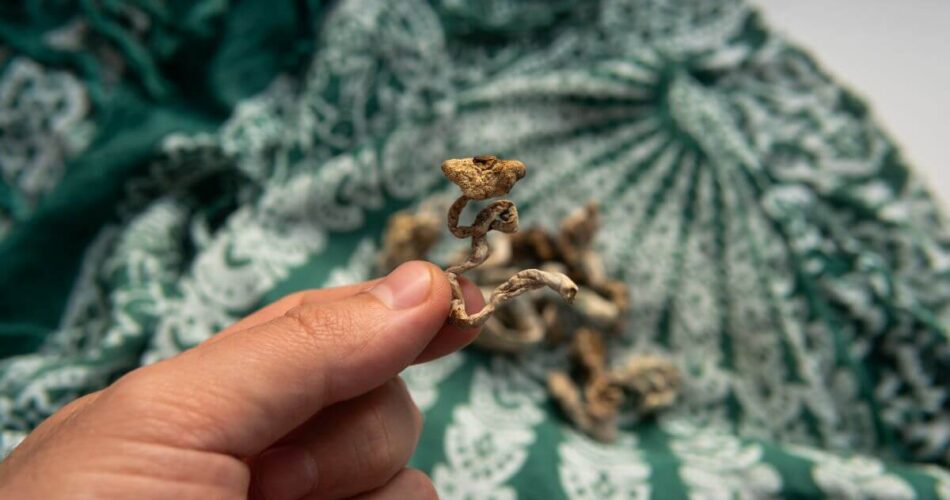In this post, we will focus on the Psilocybe caerulescens mushroom. It is found throughout the United States and has a bluish-green coloration. Read on to find out more about this intriguing fungus!
Mushrooms are fascinating creatures with a wide variety of shapes and colors. Some mushrooms are edible, while others are poisonous. It is important to know which mushrooms are safe to eat and which ones should be avoided. The Psilocybe caerulescens is a hallucinogen and should not be consumed without prior knowledge about its effects.
History of the Psilocybe Caerulescens
Psilocybe caerulescens is a psychedelic mushroom in the Psilocybe genus. The specific epithet “caerulescens” derived from the Latin word for “bluish”. This refers to the often blue bruising that can occur on these mushrooms. The species was first described by an American mycologist W. Murrill.
P. caerulescens was used by the indigenous people of Mesoamerica for spiritual and medicinal purposes. The earliest known use of this mushroom dates back to the Aztecs, who called it “Teketl” and used it in their religious ceremonies. The Mazatec people of Mexico also used P. caerulescens in their rituals, calling it “Ska Maria Pastora” or “Divine Shepherdess”.
This mushroom has been used for centuries in shamanic practices and is still used by some indigenous people today. Psilocybe caerulescens is one of the most potent psilocybin-containing mushrooms, with a high concentration of the psychoactive compound. They are commonly used to produce magic truffles.
Psilocybe Caerulescens – Habitat and Cultivation
This mushroom is native to the southeastern United States, but has also been reported in Mexico, South America, Europe, and Asia. It is considered to be one of the more potent psychedelic mushrooms, with a comparable potency to Psilocybe cubensis.
P. caerulescens grows in woodlands on well-rotted wood chips and mulch, often near deciduous trees such as oak (Quercus spp.) or sweetgum (Liquidambar styraciflua).
In the wild, P. caerulescens grows on decaying wood. It can also be cultivated on brown rice flour, soil, vermiculite, and perlite. To cultivate it, a spore syringe can be used to inoculate a substrate. The substrate should be moistened, but not wet. Once the substrate is inoculated, it should be incubated at a temperature of 18-22 degrees Celsius (64-72 degrees Fahrenheit) for 10-12 days.
Psilocybe Caerulescens – Morphology
Psilocybe caerulescens is a small, delicate psilocybin mushroom with a conical to bell-shaped cap. The caps are 2–5 cm in diameter and often have a slightly umbonate (upraised) center. The cap color is variable, ranging from pale yellow to brownish yellow, sometimes with a greenish tint. The gills are adnexed to slightly notched, and the spore print is dark brown.
The stem is 5–9 cm long by 1–2 cm thick, and equal in width throughout its length or slightly thicker towards the base. The stem is hollow, fragile, and has a tendency to break easily. It is white or pale yellow, and bruises blue when handled. The flesh is thin and white, with a mild taste and smell. Psilocybe caerulescens is also known as the “blue-staining” mushroom due to its tendency to produce blueish stains on anything it comes into contact with.
P. caerulescens typically grows on wood chips or mulch, and is often found in urban environments such as parks or gardens.
Does Psilocybe Caerulescens Contain Psilocybin?
Psilocybe caerulescens is a psychoactive mushroom that contains the active compounds psilocybin and psilocin. It is also known as the “blue-staining” mushroom due to the blue coloration that can occur when the fruit bodies are bruised. This species is closely related to Psilocybe cubensis, another well-known hallucinogenic mushroom.
It is not currently listed as a controlled substance in any country, but possession and use of this mushroom is illegal in many jurisdictions. In the United States, psilocybin and psilocin are classified as a Schedule I drug, meaning that they have a high potential for abuse and are not currently accepted for medical use.
Psilocybe Caerulescens & Similar Mushroom Species
Psilocybe caerulescens is a potent hallucinogenic mushroom which contains the psychoactive compounds psilocybin and psilocin. This species is closely related to Psilocybe cubensis, and both mushrooms share many physical similarities. Both have a brownish-red cap with white spots, and a white stem. Psilocybe caerulescens also has a blue bruising reaction, which is where it gets its name. It is also quite similar to Psilocybe mexicana, another potent mushroom species.
It’s important to remember that picking any mushrooms in the wild without proper experience and knowledge is extremely dangerous, and can be deadly. If you’re not 100% sure of the identification, don’t eat it!
Similar Posts:
- Psilocybe Subaeruginosa: Magic Mushroom From Australia. Spore Prints, Cultivation, Psilocybin Content
- Psilocybe Bohemica: A Psilocybin Mushroom From Europe. All the Information You Need to Know About the Species
- Psilocybe Caerulipes – Description of a Magic Mushroom, Its Potency and Habitat
- Psilocybe Baeocystis – Unusual Psilocybin Species. Identification, Potency & Characteristics
- Psilocybe Stuntzii (Blue Ringer). How to Identify This Psilocybin Mushroom
- Psilocybe Weilii: Good for Making Magic Mushrooms? Don’t Mistake It With Psilocybe Caerulescens
- Psilocybe Serbica. Unique Information and All You Need to Know About This Psychedelic Mushroom Species





